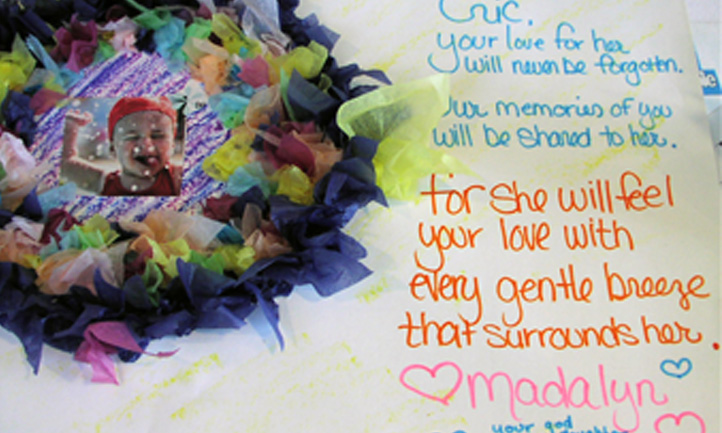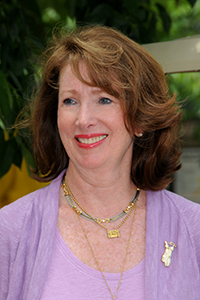The Art of Healing
Author: Sharon Strouse
National Suicide Survivor Seminar
I lay in bed with my eyes closed this Monday morning, this ninth anniversary of my daughter Kristin’s death. She ended her life on October 11, 2001. She was just 17 years old, a freshman at Parsons School of Design in New York City, with dreams of being a fashion designer. She succumbed to a misdiagnosed bi-polar illness, an illness that reared its head in January of her senior year, an illness we did not understand, an illness that destroyed all of us. My mind drifted over the past nine anniversaries. I remembered the initial shock and numbness, the emptiness, the tears, and my pain-filled body. I remembered my depression and anger and shame and regret. I remembered the full range of emotions that moved through me and noticed that today there was sadness and there was joy. Sadness and joy rested comfortably in my heart together as I opened my eyes to a beautiful clear day, just like the one nine years ago. I had come a long way. As I made my way to the kitchen and a cup of coffee, I continued to remember, and my remembering turned to the past weekend and my time at TAPS National Suicide Survivors Seminar and Good Grief Camp in Arlington, Virginia. I had spent the past several days with a few hundred suicide survivors at TAPS. I facilitated the Rita Project Open Art Studio as an art therapist and as a survivor. I facilitated as a professional who had found my way toward healing through the 100 collages I had created over an eight year period.

The studio opened its doors on Friday morning as the seminar began with its welcome and introduction. I wandered between the Rita Project Studio, just off the main lobby, and the large conference room where a few hundred had gathered. I was sure no one would be interested in creating so early in the morning. I turned my back on the large panes of glass that let in light as well as the view of a reed-lined pond. I entered the studio, which was intimate and quiet. Two rows of small tables filled the room. Fifty magazines lay on the credenza to the left. Beyond, a table held hundreds of pre-cut images. In the front of the room several more tables held materials: paper, scissors, glue sticks, colored tissue paper, bottle caps, string, beads, pastels, and watercolors.
I sat down and decided to look for images that might capture the moment, when someone peeked around the corner and asked if the studio was open. She entered the room and shared, “I couldn’t handle the talking. I had to leave.” I welcomed her in and showed her around. She didn’t seem to need much from me other than what the Rita Project Studio offered, and that was a place to pour out feelings, to express the unspeakable, to quiet the mind, and open the heart. Within a short period of time others joined her. They, too, were overwhelmed. The energy of their grief permeated the room along with a pregnant stillness interrupted only by the sound of paper tearing and tears. It was 11:00 a.m. and my fear that no one would be interested in creating early in the morning dissolved in the realization that grief has its own timetable and agenda.
By the end of the day the room had filled and emptied several times over, with those new to the experiencing their grief through a creative process and those who had tried this approach at the first Art of Healing program at the survivor’s seminar in San Diego. Some created quickly and left, while others stayed and spent hours. The sharing was rich. I will never forget the images that poured out of their broken places. I will never forget the stories that we silently witnessed as sacred observers to a sacred process.
I was moved by the woman who entered the studio and said, “I just want to look around. I’m not creative.” I welcomed her. Ten minutes later I noticed her sitting with a piece of paper and a magazine. She had torn out a few images. An hour later she was still working and two hours later she was still working. She was surprised. She laughed at herself and the notion that she couldn’t make anything, in light of the fact that something was moving through her and onto the page. Her story became visible before her, no longer trapped inside but freed. There was a sense of release.
I will never forget the young woman who sat with me in San Diego last year and cried her way through her evocative creation. I was so glad to see her again. She courageously cut and pasted images of the life she shared with her husband and his death. The white paper held it all.
I will never forget the tall young woman who pasted images of high heels into her collage, granting herself permission to move into her future.
I will never forget the woman who said she was not an artist and then sat down and made a powerful pastel drawing that captured the fullness of her anger.
I smiled when it was suggested that the studio be open all night, understanding the healing power of a creative process unleashed on those newly initiated into its warm embrace. As I cleaned up late in the afternoon, I was filled with the grace of giving and receiving. I was overwhelmed by the courage of so many survivors and their willingness to be seen through their artwork. I felt at peace.
All the TAPS artists shared their creations on tables that were set up in the lobby. The Rita Project Exhibition was healing for the creators as well as those who walked by and entered into conversations over the images they observed, images that told their story, too.
Rita Project Studio was open again on Saturday from 9:00 until 5:30 and Saturday was equally powerful. Fathers and brothers joined mothers, sisters, and wives. The tapestry of healing was made rich by the images of grief displayed in the lobby. I lingered a moment just before leaving and took it all in. After the hugs and goodbyes, I drove home on Saturday night after the banquet, opening the sunroof to the stars and the stillness of the night. I remembered a poem by Rumi that advised, “Don’t turn away! Keep your gaze on the bandaged place. That is where the light enters you.” I felt the deepest gratitude for all those who kept their eyes on the bandaged place, who entered the wound of loss, who did not turn away, but found their way through…with their creations.
I realized that Kristin’s ninth year anniversary was held in the context of my weekend with the TAPS community. There was sadness and joy; there was room for it all. I had come a long way. I sat at the kitchen table and opened a magazine. It was now my time to enter into the heart of the matter and enter into the light.
 By Sharon Strouse, MA, ATR: Sharon Strouse holds a bachelor’s degree in Psychology and a master’s degree in Art Therapy. Her collage making process, in response to the trauma of her daughter’s death, developed into a template for work with others. She is a sought-after workshop presenter, author, and artist. Her private practice in Baltimore, Maryland includes art and meditation (www.attherefuge.com). Sharon is a director for Rita Project: Baltimore, devoted to using the arts to help those who have lost someone to suicide and those who have attempted suicide to connect with the power of creating (www.ritaproject.org).
By Sharon Strouse, MA, ATR: Sharon Strouse holds a bachelor’s degree in Psychology and a master’s degree in Art Therapy. Her collage making process, in response to the trauma of her daughter’s death, developed into a template for work with others. She is a sought-after workshop presenter, author, and artist. Her private practice in Baltimore, Maryland includes art and meditation (www.attherefuge.com). Sharon is a director for Rita Project: Baltimore, devoted to using the arts to help those who have lost someone to suicide and those who have attempted suicide to connect with the power of creating (www.ritaproject.org).
